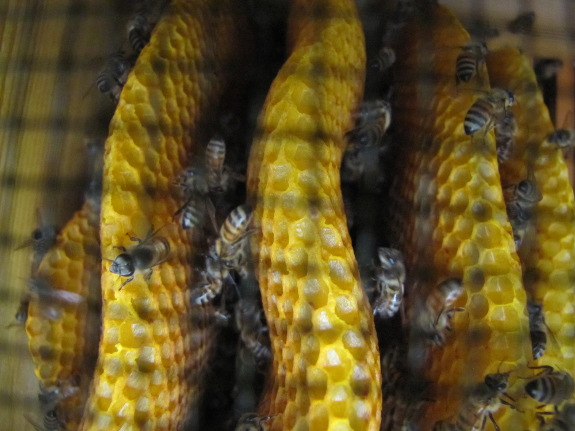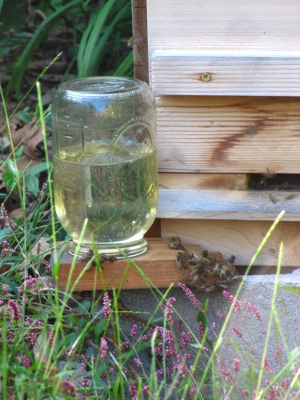
Now the bees finally want sugar water

When I peeked up under
the hive this week, I was hoping to see the third box full of capped
honey. Instead, it looked like the bees hadn't drawn any extra
comb, and the comb that existed was pretty much empty.
 With
the wingstem
nectar flow over,
the bees are reduced to scrounging through the asters and everbearing
raspberry flowers, so I decided to try again and see if they would take
sugar water now.
With
the wingstem
nectar flow over,
the bees are reduced to scrounging through the asters and everbearing
raspberry flowers, so I decided to try again and see if they would take
sugar water now.
"I don't mind if I do,"
said the bees, gulping down a pint in seven hours.
What I'm not sure about
is how much honey is in the hive at the moment. I estimated the
bees had packed away 26 pounds (one hive body full) when I did a thorough
inspection in early
September, and the third hive body looks exactly the same now as it did
then.
If the hive only has 26
pounds of honey in it, I'd need to pour 10 quarts of sugar water down
the bees' gullets before weather gets too cold for them to dehydrate
the nectar into sugar --- a tall order.
On the other hand, it's
quite possible that the bees have simply been moving honey into the
upper boxes as they slow down brood production, in which case I don't
need to feed as much. Since I can't tell the difference without
opening the hive, I'll just keep feeding as long as the bees keep
eating.
Want more in-depth information? Browse through our books.
Or explore more posts by date or by subject.
About us: Anna Hess and Mark Hamilton spent over a decade living self-sufficiently in the mountains of Virginia before moving north to start over from scratch in the foothills of Ohio. They've experimented with permaculture, no-till gardening, trailersteading, home-based microbusinesses and much more, writing about their adventures in both blogs and books.
Want to be notified when new comments are posted on this page? Click on the RSS button after you add a comment to subscribe to the comment feed, or simply check the box beside "email replies to me" while writing your comment.

Will --- Now I'm wishing I'd fed longer in the spring as some folks suggested. Oh well --- 20/20 hindsight!
We do have quite a few asters, but they don't seem to be quite so topnotch as the wingstem were. Or maybe they're just further away --- the bees barely had to get out of bed to visit the wingstem, but the asters are on the other side of the barn (maybe a city block away).
No buckwheat left, unfortunately. I killed the last of it when preparing for the garlic last month. Probably should have planted a bed or two to leave just for the bees....